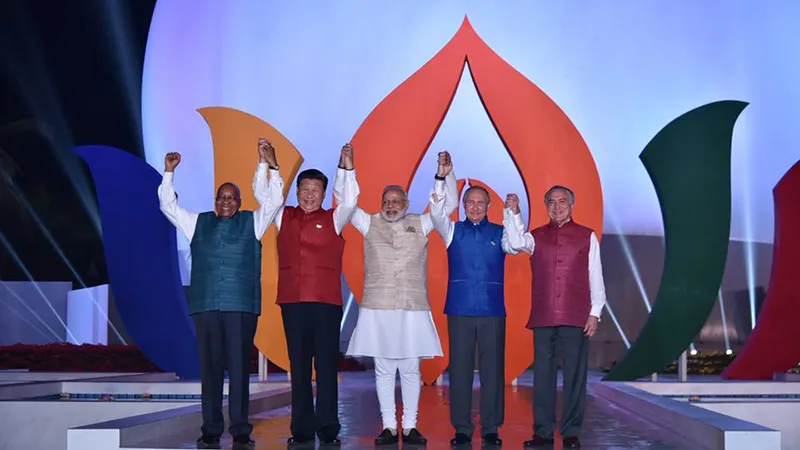With India announcing that all five BRICS member states are united in acknowledging the global threat posed by terrorism, and that those who support terror are as much a threat to us than those who perpetrate acts of terror, the eighth BRICS summit came to an end on Sunday in Goa. The BRICS agenda moved forward a bit with the BRICS leaders united in their “view to establish the BRICS Agriculture Research Platform, BRICS Railway Research Network, BRICS Sports Council, and various youth-centric fora” and agreeing “to fast track the setting up of a BRICS Rating Agency” based on market-oriented principles to “further bridge the gap in the global financial architecture.”
Prime Minister Narendra Modi said that the Goa declaration laid down “a comprehensive vision for our cooperation and coordination, within BRICS and on international issues.” But it was clear from the way India shaped the agenda of the Goa summit that Mr. Modi was working towards a different end game this time, looking beyond the immediate BRICS mandate.
< style="color: #163449;">Focus on terrorism
The Prime Minister’s focus, by and large, remained on the issue of terrorism. Without naming Pakistan, he used the BRICS platform to refer to the country as the “mothership of terrorism”, and forcefully argued that a “selective approach against terrorism” would be both futile and counterproductive. In more ways than one, he made it plain to his BRICS partners that this is an issue on which India feels rather strongly and that “BRICS needs to work together and act decisively to combat this threat.”
This message was primarily aimed at China, a country with which India has had differences on the issue of Pakistan-sponsored terrorism against India. Mr. Modi was not very successful in convincing the Chinese leadership to change Beijing’s stance on Jaish-e-Mohammad (JeM) chief Masood Azhar, who India believes was behind the Pathankot attack this year and the Parliament attack of 2001. China had recently put a technical hold once again at the United Nations and prevented Azhar from being designated a global terrorist, despite JeM being a UN-proscribed terror group.
Recognising the limits of bilateral Sino-Indian engagement, India seems to have now decided to use the leverage of a multilateral platform to put China on notice. New Delhi would be hoping that, by suggesting that “those who nurture, shelter, support and sponsor such forces of violence and terror are as much a threat to us as terrorists themselves”, it might eventually succeed in pressurising China to alter its position. However, with China refusing to budge, it is now hoped that Chinese State Councillor Yang Jiechi, who the leaders decided would travel to India again, would meet National Security Adviser Ajit Doval and discuss the issue further.
The other change that India introduced to the BRICS agenda was also significant as it underscored India’s changing priorities. India used the summit to reach out to its neighbours by initiating the BRICS-BIMSTEC outreach. Founded in 1997, the Bay of Bengal Initiative for Multi-Sectoral Technical and Economic Cooperation (BIMSTEC) now includes Nepal and Bhutan apart from Bangladesh, India, Myanmar, Sri Lanka and Thailand. Set up with the objective of enhancing technological and economic cooperation among South Asian and South-east Asian countries along the coast of the Bay of Bengal, it has been neglected so far by its members.
New Delhi has now decided to lead the regional economic cooperation efforts against the backdrop of Pakistan’s marginalisation in South Asia. The cancellation of the SAARC summit in Islamabad, with Bangladesh, Bhutan and Afghanistan deciding to stay away like India, has galvanised New Delhi’s efforts to look at new ways to foster regional cooperation. India’s outreach to BIMSTEC during the BRICS summit is an important signal that New Delhi is serious about its role as a facilitator of economic cooperation in South Asia.
< style="color: #163449;">Bilateral ties with Russia
Finally, India used the Goa summit to re-galvanise its long-standing partnership with Russia, which was in danger of losing direction. Russia’s decision to hold military exercises with Pakistan did not go down well with India at a time when it was seeking to diplomatically isolate Pakistan after the Uri terror attacks. Russia, for its part, has been concerned about India’s tilt towards the US. In Goa, the two states reaffirmed the strategic nature of their friendship once again. India signed three major deals worth billions of dollars with Russia: five S-400 Triumf air defence systems, four stealth frigates, and a joint venture to manufacture Kamov-226T utility helicopters in India.
Recognising the limits of the BRICS mandate at a time of slowing economies and growing intra-BRICS political divergences, India has tried to reimagine the multilateral forum to serve its larger strategic ends. For Mr. Modi, BRICS is an important platform to showcase to his domestic critics that his foreign policy remains independent of, and not subservient to, the US. He has cleverly used the BRICS platform to position New Delhi’s priorities on to the agenda of the forum. How far he succeeds in achieving Indian objectives will determine Indian investment in BRICS in the future.
This commentary originally appeared in The Hindu.
The views expressed above belong to the author(s). ORF research and analyses now available on Telegram! Click here to access our curated content — blogs, longforms and interviews.




 PREV
PREV


